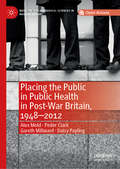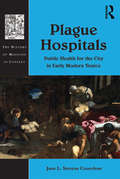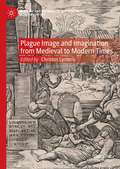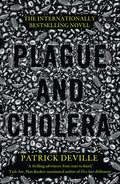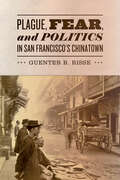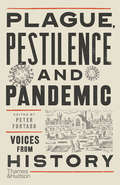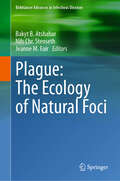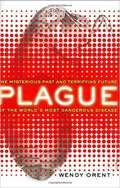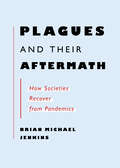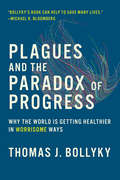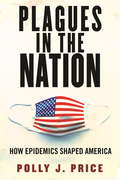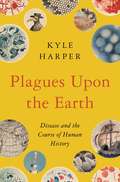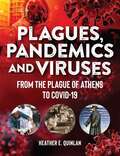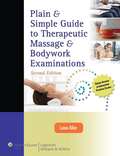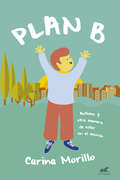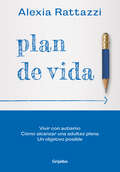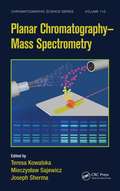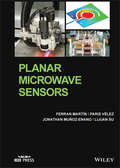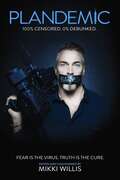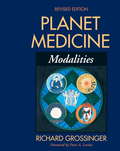- Table View
- List View
Places I've Taken My Body: Essays
by Molly McCully BrownIndispensable essays on the body, mind, and spirit by Molly McCully Brown, author of the acclaimed poetry collection, The Virginia State Colony for Epileptics and Feebleminded, a book the New York Times described as “part history lesson, part séance, part ode to dread. It arrives as if clutching a spray of dead flowers. It is beautiful and devastating.” In seventeen intimate essays, poet Molly McCully Brown explores living within and beyond the limits of a body—in her case, one shaped since birth by cerebral palsy, a permanent and often painful movement disorder. In spite of—indeed, in response to—physical constraints, Brown leads a peripatetic life: the essays comprise a vivid travelogue set throughout the United States and Europe, ranging from the rural American South of her childhood to the cobblestoned streets of Bologna, Italy. Moving between these locales and others, Brown constellates the subjects that define her inside and out: a disabled and conspicuous body, a religious conversion, a missing twin, a life in poetry. As she does, she depicts vividly for us not only her own life but a striking array of sites and topics, among them Mary Shelley’s Frankenstein and the world’s oldest anatomical theater, the American Eugenics movement, and Jerry Falwell’s Liberty University. Throughout, Brown offers us the gift of her exquisite sentences, woven together in consideration, always, of what it means to be human—flawed, potent, feeling.
Placing the Public in Public Health in Post-War Britain, 1948–2012 (Medicine and Biomedical Sciences in Modern History)
by Alex Mold Gareth Millward Peder Clark Daisy PaylingThis open access book explores the question of who or what ‘the public’ is within ‘public health’ in post-war Britain. Drawing on historical research on the place of the public in public health in Britain from the establishment of the National Health Service in 1948, the book presents a new perspective on the relationship between state and citizen. Focusing on health education, health surveys, heart disease and the development of vaccination policy and practice, the book establishes that ‘the public’ was not one thing but many. It considers how public health policy makers and practitioners imagined the public or publics. These publics were not mere constructions; they had agency and the ability to ‘speak back’ to public health. The nature of publicness changed during the latter half of the twentieth century, and this book argues that the relationship between the public and public health offers a powerful lens through which to examine such shifts.
Plague Hospitals: Public Health for the City in Early Modern Venice (The\history Of Medicine In Context Ser.)
by Jane L. CrawshawDeveloped throughout early modern Europe, lazaretti, or plague hospitals, took on a central role in early modern responses to epidemic disease, in particular the prevention and treatment of plague. The lazaretti served as isolation hospitals, quarantine centres, convalescent homes, cemeteries, and depots for the disinfection or destruction of infected goods. The first permanent example of this institution was established in Venice in 1423 and between the fifteenth and eighteenth centuries tens of thousands of patients passed through the doors. Founded on lagoon islands, the lazaretti tell us about the relationship between the city and its natural environment. The plague hospitals also illustrate the way in which medical structures in Venice intersected with those of piety and poor relief and provided a model for public health which was influential across Europe. This is the first detailed study of how these plague hospitals functioned, where they were situated, who worked there, what it was like to stay there, and how many people survived. Comparisons are made between the Venetian lazaretti and similar institutions in Padua, Verona and other Italian and European cities. Centred on the sixteenth and seventeenth centuries, during which time there were both serious plague outbreaks in Europe and periods of relative calm, the book explores what the lazaretti can tell us about early modern medicine and society and makes a significant contribution to both Venetian history and our understanding of public health in early modern Europe, engaging with ideas of infection and isolation, charity and cure, dirt, disease and death.
Plague Image and Imagination from Medieval to Modern Times (Medicine and Biomedical Sciences in Modern History)
by Christos LynterisThis edited collection brings together new research by world-leading historians and anthropologists to examine the interaction between images of plague in different temporal and spatial contexts, and the imagination of the disease from the Middle Ages to today. The chapters in this book illuminate to what extent the image of plague has not simply reflected, but also impacted the way in which the disease is experienced in different historical periods. The book asks what is the contribution of the entanglement between epidemic image and imagination to the persistence of plague as a category of human suffering across so many centuries, in spite of profound shifts in our medical understanding of the disease. What is it that makes plague such a visually charismatic subject? And why is the medical, religious and lay imagination of plague so consistently determined by the visual register? In answering these questions, this volume takes the study of plague images beyond its usual, art-historical framework, so as to examine them and their relation to the imagination of plague from medical, historical, visual anthropological, and postcolonial perspectives.
Plague Time: The New Germ Theory of Disease, First Edition
by Paul W. EwaldAccording to conventional wisdom, our genes and lifestyles are the most important causes of the most deadly ailments of our time. Conventional wisdom may be wrong. In this controversial book, the eminent biologist Paul W. Ewald offers some startling arguments: <P><P><ul> <li>Germs appear to be at the root of heart disease, Alzheimer’s, schizophrenia, many forms of cancer, and other chronic diseases.</li> <li>The greatest threats to our health come not from sensational killers such as Ebola, West Nile virus, and super-virulent strains of influenza, but from agents that are already here causing long-term infections, which eventually lead to debilitation and death.</li> <li>The medical establishment has largely ignored the evidence that implicates these germs, to the detriment of our public health.</li> <li>New evolutionary theories are available, which explain how germs function and offer opportunities for controlling these modern plagues — if we are willing to listen to them.</li> </ul> <P><P>Plague Time is an eye-opening exploration of the revolutionary new understanding of disease that may set the course of medical research for the twenty-first century.
Plague Years: A Doctor’s Journey through the AIDS Crisis
by Ross A. Slotten, MDIn 1992, Dr. Ross A. Slotten signed more death certificates in Chicago—and, by inference, the state of Illinois—than anyone else. As a family physician, he was trained to care for patients from birth to death, but when he completed his residency in 1984, he had no idea that many of his future patients would be cut down in the prime of their lives. Among those patients were friends, colleagues, and lovers, shunned by most of the medical community because they were gay and HIV positive. Slotten wasn’t an infectious disease specialist, but because of his unique position as both a gay man and a young physician, he became an unlikely pioneer, swept up in one of the worst epidemics in modern history. Plague Years is an unprecedented first-person account of that epidemic, spanning not just the city of Chicago but four continents as well. Slotten provides an intimate yet comprehensive view of the disease’s spread alongside heartfelt portraits of his patients and his own conflicted feelings as a medical professional, drawn from more than thirty years of personal notebooks. In telling the story of someone who was as much a potential patient as a doctor, Plague Years sheds light on the darkest hours in the history of the LGBT community in ways that no previous medical memoir has.
Plague and Cholera
by Patrick DevilleParis, May 1940. Nazi troops storm the city and at Le Bourget airport, on the last flight out, sits Dr Alexandre Yersin, his gaze politely turned away from his fellow passengers with their jewels sewn into their luggage. He is too old for the combat ahead, and besides he has already saved millions of lives. When he was the brilliant young protégé of Louis Pasteur, he focused his exceptional mind on a great medical conundrum: in 1894, on a Hong Kong hospital forecourt, he identified and vaccinated against bubonic plague, later named in his honour Yersinia pestis.Swiss by birth and trained in Germany and France, Yersin is the son of empiricism and endeavour; but he has a romantic hunger for adventure, fuelled by tales of Livingstone and Conrad, and sets sail for Asia. A true traveller of the century, he wishes to comprehend the universe. Medicine, agriculture, the engine of the new automobile, all must be opened up, examined and improved. Ceaselessly curious and courageous, Yersin stands, a lone genius,against a backdrop of world wars, pandemics, colonialism, progress and decadence. He is brought to vivid, thrilling life in Patrick Deville's captivating novel, which was a bestseller and shortlisted for every major literary award in France.
Plague, Fear, and Politics in San Francisco's Chinatown
by Guenter B. RisseWhen health officials in San Francisco discovered bubonic plague in their city’s Chinatown in 1900, they responded with intrusive, controlling, and arbitrary measures that touched off a sociocultural conflict still relevant today. Guenter B. Risse’s history of an epidemic is the first to incorporate the voices of those living in Chinatown at the time, including the desperately ill Wong Chut King, believed to be the first person infected.Lasting until 1904, the plague in San Francisco's Chinatown reignited racial prejudices, renewed efforts to remove the Chinese from their district, and created new tensions among local, state, and federal public health officials quarreling over the presence of the deadly disease. Risse's rich, nuanced narrative of the event draws from a variety of sources, including Chinese-language reports and accounts. He addresses the ecology of Chinatown, the approaches taken by Chinese and Western medical practitioners, and the effects of quarantine plans on Chinatown and its residents. Risse explains how plague threatened California’s agricultural economy and San Francisco’s leading commercial role with Asia, discusses why it brought on a wave of fear mongering that drove perceptions and intervention efforts, and describes how Chinese residents organized and successfully opposed government quarantines and evacuation plans in federal court. By probing public health interventions in the setting of one of the most visible ethnic communities in United States history, Plague, Fear, and Politics in San Francisco’s Chinatown offers insight into the clash of Eastern and Western cultures in a time of medical emergency.
Plague, Pestilence and Pandemic: Voices From History
by Peter FurtadoAn eye-opening anthology from the bestselling editor of Histories of Nations, exploring how people around the globe have suffered and survived during plague and pandemic, from the ancient world to the present. Plague, pestilence, and pandemics have been a part of the human story from the beginning and have been reflected in art and writing at every turn. Humankind has always struggled with illness; and the experiences of different cities and countries have been compared and connected for thousands of years. Many great authors have published their eyewitness accounts and survivor stories of the great contagions of the past. When the great Muslim traveler Ibn Battuta visited Damascus in 1348 during the great plague, which went on to kill half of the population, he wrote about everything he saw. He reported, "God lightened their affliction; for the number of deaths in a single day at Damascus did not attain 2,000, while in Cairo it reached the figure of 24,000 a day." From the plagues of ancient Egypt recorded in Genesis to those like the Black Death that ravaged Europe in the Middle Ages, and from the Spanish flu of 1918 to the Covid-19 pandemic in our own century, this anthology contains fascinating accounts. Editor Peter Furtado places the human experience at the center of these stories, understanding that the way people have responded to disease crises over the centuries holds up a mirror to our own actions and experiences. Plague, Pestilence and Pandemic includes writing from around the world and highlights the shared emotional responses to pandemics: from rage, despair, dark humor, and heartbreak, to finally, hope that it may all be over. By connecting these moments in history, this book places our own reactions to the Covid-19 pandemic within the longer human story.
Plague-Making and the AIDS
by Gina M. BrightCaptures the social, political, and medical discrimination experienced by people with AIDS in the US, which has resulted from our culture's construction of the disease as a plague.
Plague: The Ecology of Natural Foci (Birkhäuser Advances in Infectious Diseases)
by Nils Chr. Stenseth Jeanne M. Fair Bakyt B. AtshabarThis book provides deep insights into the ecology of the plague bacterium Yersinia pestis in natural foci, its diversity, genetic variability and the function of the vector, thus painting a holistic picture of how plague pandemics have evolved and how the bacterium has adapted perfectly to its environment over such a long period of time. The book reviews studies of several generations of scientists from the countries of the former Soviet Union where plague foci are found and presents them for the first time to a global audience. In addition, the book provides comprehensive information on historical plague pandemics and explores future strategies for managing the disease.
Plague: The Mysterious Past and Terrifying Future of the World's Most Dangerous Disease
by Wendy OrentA history of the plague documents its outbreaks from the early Roman Justinian plague, to the Black Death, to more recent occurrences, identifying the conditions that can precipitate an epidemic and offering a sobering prognosis for its potential as a bioterrorist weapon.
Plagues (The Darwin College Lectures)
by Sven Friedemann Jonathan L. HeeneyPlagues have inflicted misery and suffering throughout history. They can be traced through generations in our genes, with echoes in religion and literature. Featuring essays arising from the 2014 Darwin College Lectures, this book examines the spectrum of tragic consequences of different types of plagues, from infectious diseases to over-population and computer viruses. The essays analyse the impact that plagues have had on humanity and animals, and their threat to the very survival of the world as we know it. On the theme of plagues, each essay takes a unique perspective, ranging from the impact of plagues on history, medicine, the evolution of species, and biblical metaphors, to their impact on national economies, and even our highly connected digital lifestyles. This engaging and timely collection challenges our understanding of plagues, and asks if plagues are the manifestation of nature's checks and balances in light of human population growth and our impact on climate change. A stimulating collection of essays written by a distinguished group of scholars with a diverse approach to their theme. Provides a multidisciplinary examination of the effects of plagues, from early history to current medicine and the future. Analyses different types of plagues, from infectious diseases to over-population and computer viruses.
Plagues and Their Aftermath: How Societies Recover from Pandemics
by Brian Michael JenkinsA look at the long history of epidemics and pandemics provides an enthralling account of what we can expect of a post-COVID worldIn a concise, authoritative, and gripping telling, Brian Michael Jenkins — one of our leading authorities on national security and an advisor to governments, presidents and CEOs — provides a masterly account of what kind of future the planet might be facing ... by looking at the world's long history of epidemics and discerning what was common about their aftermath. From a plague in Athens during the Peloponnesian War in 430 BCE, to another in 540 that wiped out half the population of the Roman empire, down through the Black Death in the Middle Ages and on through the 1918 flu epidemic (which killed between 50 and 100 million people) and this century's deadly SARS outbreak, plagues have been a much more relentless fact of life than many realize. The legacy of epidemics, Jenkins observes, is not only one of lives lost but of devastated economies and social disorder, all of which have severe political repercussions. Thus, each chapter of Plagues and Their Aftermath draws on those historical precursors to focus on one particular aspect of their aftermath: What happens to political systems? What happens in the area of crime and terrorism? Do wars happen? What are the effects on cultures? What was the impact of widespread fear and public hysteria, of increased suspicion and scapegoating, of the spread of rumors and conspiracy theories? Jenkins' sobering analysis is riveting and thought-provoking reading for general readers and specialists alike, and throws welcome light into what many fear is a dark future.
Plagues and the Paradox of Progress: Why the World Is Getting Healthier in Worrisome Ways (The\mit Press Ser.)
by Thomas J. BollykyWhy the news about the global decline of infectious diseases is not all good.Plagues and parasites have played a central role in world affairs, shaping the evolution of the modern state, the growth of cities, and the disparate fortunes of national economies. This book tells that story, but it is not about the resurgence of pestilence. It is the story of its decline. For the first time in recorded history, virus, bacteria, and other infectious diseases are not the leading cause of death or disability in any region of the world. People are living longer, and fewer mothers are giving birth to many children in the hopes that some might survive. And yet, the news is not all good. Recent reductions in infectious disease have not been accompanied by the same improvements in income, job opportunities, and governance that occurred with these changes in wealthier countries decades ago. There have also been unintended consequences. In this book, Thomas Bollyky explores the paradox in our fight against infectious disease: the world is getting healthier in ways that should make us worry. Bollyky interweaves a grand historical narrative about the rise and fall of plagues in human societies with contemporary case studies of the consequences. Bollyky visits Dhaka—one of the most densely populated places on the planet—to show how low-cost health tools helped enable the phenomenon of poor world megacities. He visits China and Kenya to illustrate how dramatic declines in plagues have affected national economies. Bollyky traces the role of infectious disease in the migrations from Ireland before the potato famine and to Europe from Africa and elsewhere today. Historic health achievements are remaking a world that is both worrisome and full of opportunities. Whether the peril or promise of that progress prevails, Bollyky explains, depends on what we do next.A Council on Foreign Relations Book
Plagues in the Nation: How Epidemics Shaped America
by Polly J. PriceSheds light on the US government&’s response to epidemics through history—with larger conclusions about COVID-19 and reforms needed before the next plague.In this narrative history of the US through major outbreaks of contagious disease, from yellow fever to the Spanish flu, from HIV/AIDS to Ebola, Polly J. Price examines how law and government affected the outcome of epidemics—and how those outbreaks in turn shaped our government. Price presents a fascinating history that has never been fully explored and draws larger conclusions about the gaps in our governmental and legal response. Plagues in the Nation examines how our country learned—and failed to learn—how to address the panic, conflict, and chaos that are the companions of contagion, what policies failed America again and again, and what we must do better next time.
Plagues upon the Earth: Disease and the Course of Human History (The Princeton Economic History of the Western World #106)
by Kyle HarperA sweeping germ’s-eye view of history from human origins to global pandemicsPlagues upon the Earth is a monumental history of humans and their germs. Weaving together a grand narrative of global history with insights from cutting-edge genetics, Kyle Harper explains why humanity’s uniquely dangerous disease pool is rooted deep in our evolutionary past, and why its growth is accelerated by technological progress. He shows that the story of disease is entangled with the history of slavery, colonialism, and capitalism, and reveals the enduring effects of historical plagues in patterns of wealth, health, power, and inequality. He also tells the story of humanity’s escape from infectious disease—a triumph that makes life as we know it possible, yet destabilizes the environment and fosters new diseases.Panoramic in scope, Plagues upon the Earth traces the role of disease in the transition to farming, the spread of cities, the advance of transportation, and the stupendous increase in human population. Harper offers a new interpretation of humanity’s path to control over infectious disease—one where rising evolutionary threats constantly push back against human progress, and where the devastating effects of modernization contribute to the great divergence between societies. The book reminds us that human health is globally interdependent—and inseparable from the well-being of the planet itself.Putting the COVID-19 pandemic in perspective, Plagues upon the Earth tells the story of how we got here as a species, and it may help us decide where we want to go.
Plagues, Pandemics And Viruses: From The Plague Of Athens To Covid 19
by Heather E. QuinlanPandemics can come in waves―like tidal waves. They change societies. They disrupt life. They end lives. As far back as 3000 B.C.E. (the Bronze Age), plagues have stricken mankind. COVID-19 is just the latest example, but history shows that life continues. It shows that knowledge and social cooperation can save lives. Viruses are neither alive nor dead and are the closest thing we have to zombies. Their only known function is to replicate themselves, which can have devastating consequences on their hosts. Most, but not all, bacteria are good for us. Some are truly horrific, including those that caused the bubonic, pneumonic, and septicemic plagues. And viruses and bacteria are always morphing, evolving, and changing, making them hard to treat. Plagues, Pandemics, and Viruses: From the Plague of Athens to Covid 19 is an enlightening, and sometimes frightening, recounting of the destruction wrought by disease, but it also looks at what man has done and can do to overcome even the deadliest and bleakest of contagions. More than two years in the making, author Heather E. Quinlan was deep into her research and writing when COVID hit. She quickly saw the similarities to plagues from the past. Plagues, Pandemics, and Viruses: From the Plague of Athens to Covid 19 not only covers the history, causes, medical treatments, human responses, and aftermath of the world’s biggest pandemics, but it also draws parallels to the present. It chronicles the diseases that have inflicted man throughout the millennia, including … The differences (and similarities) between COVID-19 and other coronaviruses The bubonic plague/black plague, which wiped out 30% to 60% of Europe’s population The devastation to the indigenous population during the European colonization of the Americas The 1918 Spanish Flu, which did not come from Spain How disease “inspired” The Canterbury Tales, Wuthering Heights, the pop art of Keith Haring, and other art and literature AIDS’ “patient zero” How climate change will affect future pandemics The aftermath of various pandemics Several modern diseases making a comeback … and much, much more. Along with investigating some of history’s most notorious pandemics and diseases, Plagues, Pandemics, and Viruses takes a look at human resilience and what we’ve learned from the past. It looks at how science, the medical community, and governments have conquered or mitigated most epidemics even before they can turn into pandemics. It reviews the science of pandemics, preventative measures, and medical interventions and it includes an exclusive interview with Dr. Anthony S. Fauci, director of the National Institute of Allergy and Infectious Diseases, as well as other experts in the medical community. Richly illustrated, it also has a helpful bibliography and extensive index. This invaluable resource is designed to help you understand, and protect you from, plagues, pandemics, epidemics, viruses, and disease!
Plain and Simple Guide to Therapeutic Massage and Bodywork Examinations (2nd edition)
by Laura AllenThis comprehensive review guide for therapeutic massage and bodywork certification is written in plain, simple language to put the test-taker at ease. The book is organized according to the National Certification Examination, and each chapter is presented as an outline review, with end-of-chapter review questions. Positive affirmations and quotations help calm the reader's test-taking anxiety. This Second Edition provides coverage of the Massage & Bodywork Licensing Exam (MBLEx) and includes at least five additional review questions per chapter. A companion Website offers student and instructor resources such as practice exams, interactive flash cards, game show questions, Millionaire game questions, labeling activities, a quiz bank, a test generator, a syllabus, lesson plans, and PowerPoint slides.
Plan B: Autismo y otra manera de estar en el mundo
by Carina MorilloEn Plan B, Carina Morillo no solo nos ofrece un testimonio sincero del viaje personal luego de que su hijo fuera diagnosticado con autismo, sino también una guía práctica y esperanzadora para quienes quieran desarrollar la resiliencia y así enfrentar los desafíos que la vida nos presenta. En 2002, Carina Morillo vivía en Luxemburgo junto a su familia. Al cumplir su hijo menor, Iván, los dos años y medio fue diagnosticado con autismo, y entonces decidieron volver a la Argentina. Ese regreso se convirtió para ella en un camino de transformación. Fue darse cuenta de que su currículum de logros no le servía para nada frente a las dificultades que su hijo tenía que enfrentar, y que su única certeza era que quería la felicidad de Iván. Que su familia fuese feliz. Ser feliz ella misma. Por nada del mundo se iba a apartar de ese objetivo. Descarnado e inspirador, Plan B trata sobre el poder del amor y el coraje frente a los obstáculos y las oportunidades que pueden surgir cuando nos despejamos de nuestros prejuicios y aprendemos a aprovechar nuestro verdadero potencial. Una invitación a mirar la realidad como un lugar de eternas posibilidades.
Plan de vida: Vivir con autismo. Cómo alcanzar una adultez plena. Un objetivo posible
by Alexia RattazziEn este nuevo libro Alexia Rattazzi, doctora especialista en autismo, propone ideas, experiencias y herramientas para acompañar a personas adultas con autismo a llevar una vida social plena, libre y autónoma. Me encantaría vivir en un mundo en el que cada persona sea quien es y pueda ejercer sus derechos plenamente, en igualdad de condiciones que las demás. Todos tenemos derecho a elegir qué hacer de nuestras vidas. Pero ¿cómo garantizarles hoy, en esta sociedad, ese ejercicio pleno de derechos a las personas con autismo? Lo primero es visibilizar esta condición. Identificar y derribar barreras, brindar apoyos y pensar caminos posibles. En este, su nuevo libro, Alexia Rattazzi, especialista en autismo, aborda problemas como el del acceso a la salud, a la educación superior, al empleo con apoyos en el mercado laboral abierto y competitivo, a la independencia y a la autodeterminación. A vivir donde y con quien se quiera, a la sexualidad y las relaciones afectivas, a la justicia, al turismo, al deporte, al ocio, a la recreación, a la comunicación y al bienestar. En definitiva, a todas esas cosas que nos permiten disfrutar de nuestro paso por el mundo, a solas o en compañía. Plan de vida es una invitación a construir una convivencia humana neurodiversa y pacífica y a seguir creando contextos amigables y amables para todos.
Planar Chromatography - Mass Spectrometry (Chromatographic Science Series)
by Teresa Kowalska Mleczyslaw Sajewlcz Joseph SharmaPlanar Chromatography-Mass Spectrometry focuses on a relatively new approach to chemical analysis in general, and to separation science in particular. It is the first book to systemically cover the theoretical background, techniques, instrumentation, and practical applications of planar chromatography-mass spectrometry as a hyphenated tool of analy
Planar Microwave Sensors (IEEE Press)
by Ferran Martín Paris Vélez Jonathan Muñoz-Enano Lijuan SuComprehensive resource detailing the latest advances in microwave and wireless sensors implemented in planar technology Planar Microwave Sensors is an authoritative resource on the subject, discussing the main relevant sensing strategies, working principles, and applications on the basis of the authors’ own experience and background, while also highlighting the most relevant contributions to the topic reported by international research groups. The authors provide an overview of planar microwave sensors grouped by chapters according to their working principle. In each chapter, the working principle is explained in detail and the specific sensor design strategies are discussed, including validation examples at both simulation and experimental level. The most suited applications in each case are also reported. The necessary theory and analysis for sensor design are further provided, with special emphasis on performance improvement (i.e., sensitivity and resolution optimization, dynamic range, etc.). Lastly, the work covers a number of applications, from material characterization to biosensing, including motion control sensors, microfluidic sensors, industrial sensors, and more. Sample topics covered in the work include: Non-resonant and resonant sensors, reflective-mode and transmission-mode sensors, single-ended and differential sensors, and contact and contactless sensors Design guidelines for sensor performance optimization and analytical methods to retrieve the variables of interest from the measured sensor responses Radiofrequency identification (RFID) sensor types, prospective applications, and materials/technologies towards “green sensors” implementation Comparisons between different technologies for sensing and the advantages and limitations of microwave sensors, particularly planar sensors Engineers and qualified professionals involved in sensor technologies, along with undergraduate and graduate students in related programs of study, can harness the valuable information inside Planar Microwave Sensors to gain complete foundational knowledge on the subject and stay up to date on the latest research and developments in the field.
Plandemic: Fear Is the Virus. Truth Is the Cure.
by Mikki WillisThe incredible true story of the most banned documentary in history. Researching the controversy arising after the release of the viral phenomenon known as Plandemic, the most seen and censored documentary in history, an investigative journalist sets out to disprove and debunk claims made throughout the film. Instead, the journalist opens a Pandora&’s box to witness firsthand an underworld of corruption, lies, and the darkest of unsolved mysteries. The result? A fascinating behind-the-scenes account about the making of Plandemic and Plandemic: Indoctornation; an exposé of the truth behind the origins of COVID-19; an alarming examination of individuals, such as Dr. Anthony Fauci and Bill Gates, and organizations like the CDC, NIH, WHO, and Bill & Melinda Gates Foundation, among others, driving the global vaccination agenda; and a look at the tech giant and mainstream media forces doing their utmost to silence and suppress the veracity of these findings. Investigative filmmaker Mikki Willis focuses his unflinching lens on two key subjects: virologist Dr. Judy Mikovits, who speaks frankly about the machinations for control and profit corrupting individuals and institutions tasked with overseeing public health; and Dr. David E. Martin, whose research and shocking data corroborate allegations of conflicts of interest. The US media and fact checkers condemned the two documentaries as &“dangerous conspiracy theory.&” Today, the two-part bombshell is being hailed globally for warning the world of the crimes against humanity that are just now being uncovered. From the death of his brother and mother due to bad medicine, to his awakening at Ground Zero on 9/11, Mikki Willis describes in detail the incredible life experiences that led him to risk his career and safety to create the Plandemic series.
Planet Medicine: Modalities, Revised Edition
by Peter A. Levine Richard GrossingerPlanet Medicine is a major work by an anthropologist who looks at medicine in a broad context. In this edition, additions to this classic text include a section on Reiki, a comparison of types of palpation used in healing, updates on craniosacral therapy, and a means of understanding how different alternative medicines actually work. Illustrated throughout, this is the standard on the history, philosophy, and anthropology of this subject.

